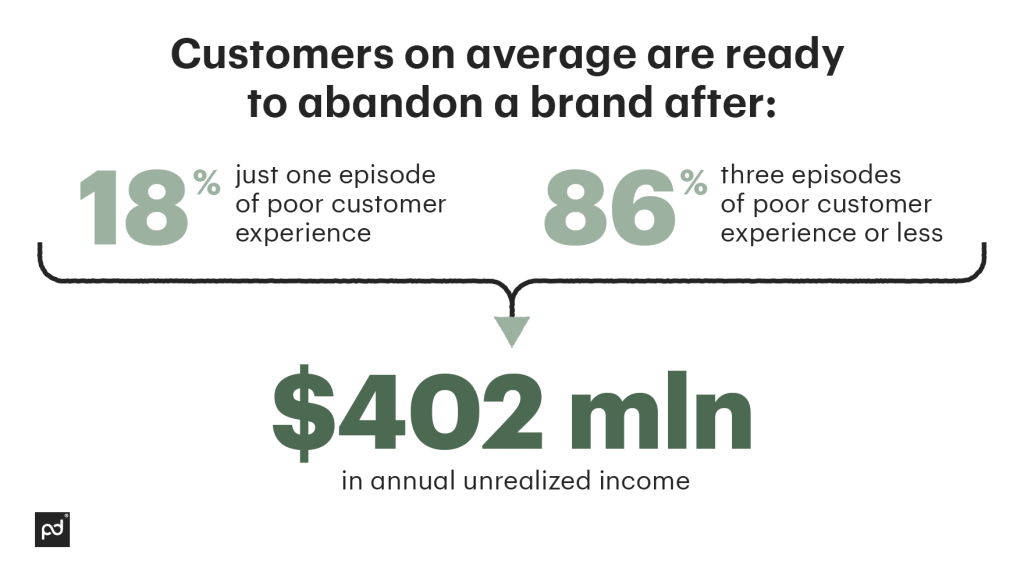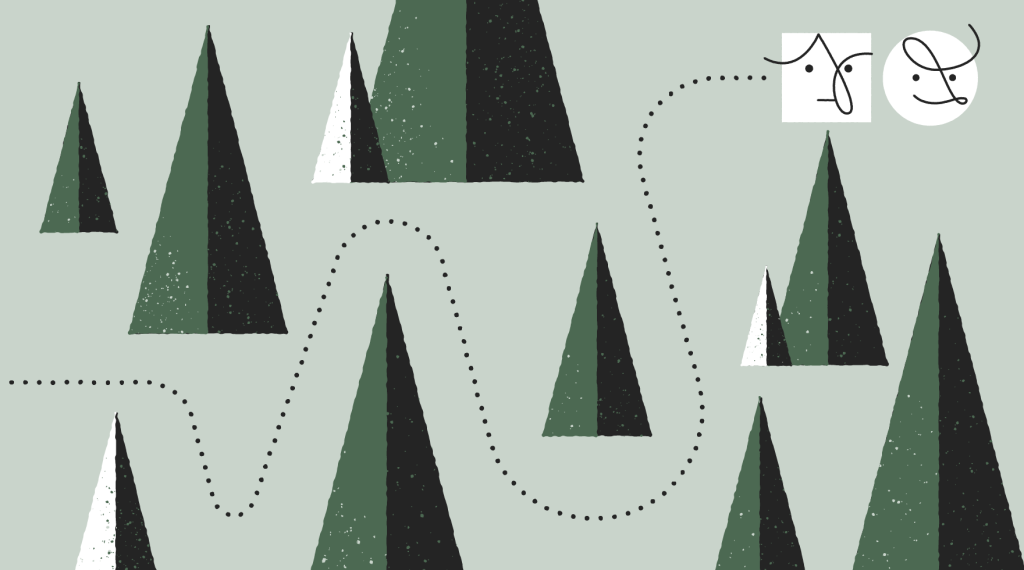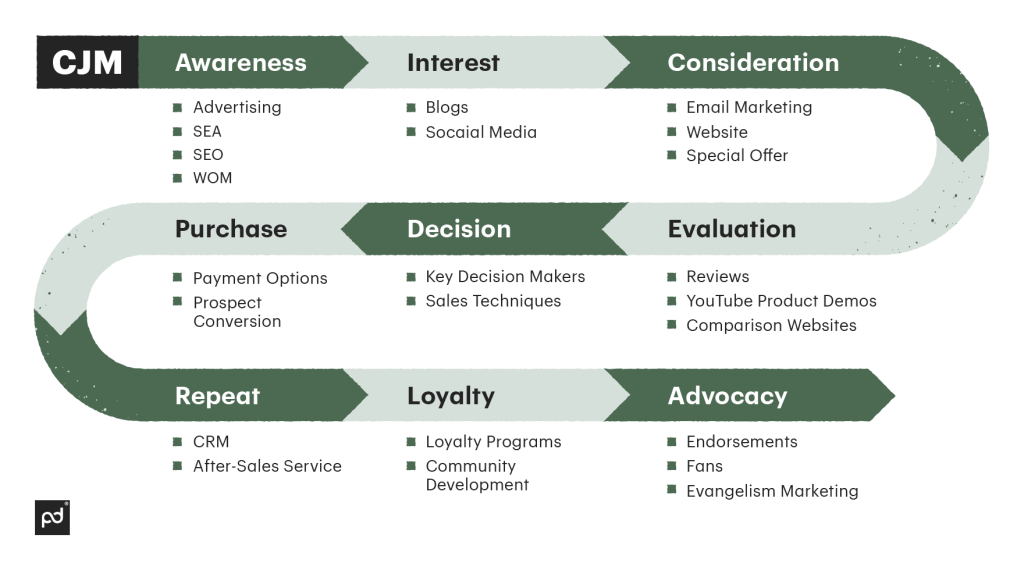Each user has their own relationship story with your brand, beginning with the very first engagement. And this story can easily stop at every single stage.
Research conducted by Emplifi illustrates the issue clearly: 18% of customers on average are ready to abandon a brand after just one episode of poor customer experience, while 86% are willing to do this after three episodes or less.

Globally, this results in a total of $402 billion in annual unrealized income, according to the Siegel+Gale study.
That’s why understanding the most probable behavior of your customers at every stage of their journey is so crucial.
This understanding maximizes the chances of a user turning into your customer, rather than going to competitors.
With the content below, you’ll:
- Find out what customer journey mapping is and examples of the customer journey map
- Understand the difference between customer journey mapping and analysis
- Read a detailed explanation of why CJM is so important
- Explore all the essential components of customer journey maps
- Learn the steps required for building your customer journey maps successfully
- Choose from an assortment of free templates for each existing CJM type

What are a customer journey map and customer journey analytics?
There are various definitions of customer journey mapping and customer journey analytics. What follows is our best-in-class version. It’ll help ensure everything that follows stays on the same page.
A customer journey map (or CJM, user journey map, UX map) is a detailed and visualized way of describing how your potential customers will interact with your brand from the very first touchpoint.
In other words, CJM is a diagram presenting the possible interactions between your future customer and your business.
As a result, customer journey mapping is just the process of building a CJM.
Customer journey analytics, on the other hand, is a more advanced and efficient technique for understanding user behavior, as it’s based on data that represents what has happened.
The main difference lies in the fact that CJM is built based mostly on assumptions.
The marketing team creates a few personas of the most typical potential buyers and then tries to predict all their actions, and in context, during the journey.
Analytics, on the other hand, is focused on real buyers and their actions. The marketing team reviews them continuously in real-time, adding required changes as needed.
This approach generally requires more labor but also brings in more accurate results.
An important note: You must start with the mapping even if customer journey analytics produce more ROI.
Otherwise, you might be launching your product or service without any user behavior research, which is highly risky and can even destroy your business before it has a chance to get off the ground.
And we’re certain you don’t want that, right?
Benefits of the customer journey mapping process
In a nutshell, customer journey mapping helps understand and address customer behaviors and customer experience, pain points, and desires much better than attempting to comprehend these aspects without them.
All other customer experience benefits originate from this statement. Let’s briefly depict them.
1. CJM helps identify buyer personas and match their needs
Having just an idea of what your product is or the service you provide only allows you to make assumptions about whom it’ll be most helpful for and how.
And these assumptions are often more inaccurate than not. Using CJM, you can determine what kind of people or businesses are really in need of what you’re offering.
Then, based on these features, it is much easier to match your product with customers’ real needs, rather than just those perceived needs that were in your mind beforehand.
2. CJM decreases customer churn while increasing retention rates and lifetime value
A properly crafted customer journey map, among other things, focuses on how and why users abandon what they almost purchased or how they act once they’ve already bought.
When you know what particular issues cause your potential buyers to leave, you can fix these issues and increase your conversion rate.
For the users who become buyers, customer journey mapping opens a way to turn them into returning customers or even advocates of your brand.
As a result, their LTV will increase, as well as the retention rate.
3. CJM decreases the customer support workload
The less you know your customers, the more potential exists for them to be confused or disappointed with your product or service.
In addition, any single customer experience issue could become a reason for a support ticket.
Therefore, an obvious conclusion presents itself: the fewer CX issues you have, the less frequent those tickets will arrive.
4. CJM makes sales and marketing teams more efficient and data-driven
Customer journey mapping also helps keep all the involved departments on the same page.
This is a convenient and effective way to eliminate mishaps and misunderstandings between sales and marketing teams in terms of goals, mutual effort, and efficient interaction.
The desirable result is to encourage all teams and team members to stop competing and start collaborating, which serves to boost overall efficiency.
Using metrics instead of assumptions is also an efficient approach to more accurate personal and team-based outcomes evaluation.
5. CJM helps find and eliminate flaws and bottlenecks in the processes
A deep understanding of user behavior is key to assessing and reassessing your own work. Once you know for sure when and how to react to various users’ actions, you can review your processes.
Once reviewed, you may find them too generic to be efficient.
Tune your processes in accordance with the customer journeys, and very soon you’ll see how some of your actions will become much simpler and how you can decrease your operational expenditures.
Customer journey mapping essentials
Each customer journey map must contain several integral components; otherwise, its value becomes highly questionable.
Below, you can find them listed, along with the explanations required for a proper understanding.
Stages of the journey and Kotler’s five A’s
Each and every customer journey goes through several certain stages of the funnel.
There are many different classifications for these stages in existence. One of the most comprehensive is as follows:
- Awareness
- Interest
- Consideration
- Evaluation
- Decision
- Purchase
- Repeat
- Loyalty
- Advocacy

Philip Kotler, a legend of modern marketing theory, invented a framework for efficiently mapping a customer journey through the process of sales.
The framework, called the Five A’s, offers an alternative classification of the journey, dividing the journey into these five stages:
- Awareness. At this stage, the person is just getting to know the brand. The stage starts with any attention trigger forcing the buyer to engage with the brand, and finishes once the buyer knows the brand.
- Appeal. At this stage, the ball’s in your court. This means that your product or service must somehow attract the interest of the buyer. It could be a unique selling proposition, interesting features, viral advertising, or something else acting as an interest magnet.
- Ask. If the previous stage was successful, the customer begins searching for more information about your product or service. Your goal is to provide them with the sought-after or required information within the channels that are the most convenient for them. This is also a time for checking your online reputation.
- Act. Once the information is provided and the customer is satisfied with the info they’ve obtained, it’s time to make a purchase. You should, whenever possible, trigger it, using available tools (discount is the simplest one), and then make sure that the customer is satisfied with the purchase.
- Advocacy. This stage happens only if the previous ones were fully successful and the buyer’s satisfaction is high. Only satisfied customers become advocates who spread positive words about your product or service.
According to the framework, not all these stages are obligatory for every customer journey.
Depending on the context and specific conditions, the number of stages could be less than five.
Actions
Going through the stages, users do something at each one. For example, at the awareness stage, they can seek out and find all the necessary information at your website — or drop it altogether and search for another source.
At the consideration stage, they usually compare your offer with the competing ones.
At the advocacy stage, they spread the word about your product or service in a positive way.
Emotions
Each action during the journey produces certain emotions: satisfaction, happiness, frustration, etc.
As we said before, these emotions are highly important in terms of continuation or interruption of the journey.
Tracking and analyzing these emotions make it possible to eliminate or lower the negative responses, increasing the overall CX quality.
Pain points
Negative emotions are tied to the pain points triggering them. By considering these points as the drawbacks your customers are experiencing, you can analyze them and find the root causes.
Solutions
You must determine and then implement the most appropriate solutions for as many pain points in your customer journey as it is possible to address.
The journey should contain the least amount of unaddressed pain points in order to provide acceptable conversion rates.
Buyer personas
This is also a crucial component, but it deserves a separate block in the article. A buyer persona is a description of your ideal customer, with an overview of features and details.
This doesn’t mean you should brainstorm until you come up with as many details as possible; instead, make sure the features you include are somehow tied to the customer journey.
For example, the color of a necktie is absolutely unnecessary when we speak about selling medication. But it makes sense if you’re selling jackets.
Allergy to wool is a highly important feature for dog breeders but completely unessential for software sellers.
Customer touchpoints
A touchpoint is a place in the customer journey which can trigger the user to form an opinion about your product, service, or business.
Each separate episode of direct interaction between the customer and your business must be considered a touchpoint.
The touchpoints can be found across all the possible channels, both online and offline. Some examples of touchpoints:
- Reading an article from your corporate blog can be a positive touchpoint if the article is good enough, or negative if it is not. Even if the text of your article is wise and valuable, a poor layout can lead to a negative touchpoint.
- Any error message displayed on your website is a negative touchpoint. Always.
- When the best friend of a customer appears to have a good opinion about your brand independently from the customer, this is a positive touchpoint.
As you see, it is much easier to turn a positive touchpoint into a negative than a negative touchpoint into a positive one.
Focus range
The focus of the customer journey map can vary from very wide to laser-sharp.
In the first extreme, there is a customer journey map that tracks all the possible touchpoints, including even those which exist far from the journey.
Such an approach allows you to get a holistic view of your funnel and the overall business.
In the second extreme, there is a customer journey map customized around a single touchpoint only. This touchpoint covers all pertinent aspects, making in-depth analysis possible.
Other aspects that are irrelevant to the selected touchpoint are usually ignored. This approach is highly applicable when you need to investigate any localized issue of uncertain origin.
Types of customer journey maps
For every single “customer-brand” pair, it is possible to build four different types of CJM.
Selecting which one is the best fit is based on the purpose or reasons why you’re creating your customer journey map.
1. Current state map
The most popular is the current state map. This CJM illustrates how the journey looks “as is.”
The current state map is convenient for analyzing the wide range of factors and improving the funnel continuously.
2. Future state map
The future state of CJM shows what the customer journey should look like going forward. In other words, it illustrates the ideal customer journey you’re striving to obtain.
As a result, this type of map is the most efficient when you need to find possible improvements for your current (and perhaps flawed) customer journey. It is also effective for strategic planning.
3. Day in the life map
A day in the life map looks interesting, especially when compared to the previous two types.
It focuses on all the possible touchpoints from both inside and outside your company during a limited period of time (usually one day).
This CJM type allows you to analyze pain points from your customers’ real life that exists far away from your business.
4. Service blueprint map
The service blueprint type sits a bit apart from the previous three. Moreover, there is no consensus on whether it is CJM or a neighboring but separate technique.
The key here is that the field of application is limited by services, not products, and the goal of the service blueprint is to understand how internal factors impact customer touchpoints.
That’s why the only similar component here is customer action, while all the others are different. This component forms the basis, acting as a timeline analog.
Other components are tied to the internal processes, which impact customer touchpoints: visible (frontstage) and invisible (backstage) interactions; support processes; and visibility and interaction lines.
A detailed description of the service blueprint technique deserves a separate article.
Free customer journey map templates
Within the scope of our work and product offerings, the PandaDoc team has designed custom CJM templates.
And we’re pleased to offer these templates for free.
All the types presented below were thoroughly tested by our experts in the real world, so we’re deadly sure of their quality.
Current state customer journey map template
| Customer journey current state | Step 1 | Step 2 | Step 3 | Step 4 | Step 5 |
|---|---|---|---|---|---|
| What is the customer thinking or feeling? | |||||
| What is the customer’s action? | |||||
| What is the customer’s touchpoint with the business? | |||||
| What do we want to change about this step? | |||||
| How and/or why will we make this change? |
Future state customer journey map template
| Customer journey future state | Step 1 | Step 2 | Step 3 | Step 4 | Step 5 |
|---|---|---|---|---|---|
| What is the customer thinking or feeling? | |||||
| What is the customer’s action? | |||||
| What is the customer’s touchpoint with the business? | |||||
| How does the above section differ from the current or previous state? | |||||
| Why do we feel this will alter the customer journey? |
Day in the life customer journey map template
| Customer journey: A day in a life | 5.00 am | 9:00 am |
12:00 pm | 6:00 pm |
12:00 pm |
|---|---|---|---|---|---|
| What is the customer thinking or feeling? | |||||
| What are the customer’s actions or main priorities? | |||||
| What are the customer’s biggest pain points at this time? | |||||
| How does the customer interact with our product at this time? | |||||
| How can our product be better utilized at this time? |
Service blueprint template
| Service and support | Normal use | Complaint | Needs help | Chats with support | Resolution |
|---|---|---|---|---|---|
| What is the customer feeling? | |||||
| Why is the customer feeling this way? | |||||
| How do we communicate with the customer? | |||||
| What action do we take in the background? |
8 steps of the successful customer journey mapping process
Step 1. Set clear goals
Before you dive into mapping out your next experience, you need to define the goals you are trying to achieve.
Start by answering these questions:
- What is the main purpose of this map creation?
- Who is this messaging for?
With answers in mind, you can proceed to the next step.
Step 2. Conduct research to know your buyer personas
If your product or service hasn’t yet launched, or you don’t yet have customers for some other reason, you must first conduct market research to get the required data.
Use the data available from your prospective customers, ones that would be a good fit. The best source is likely Google Analytics.
You can also conduct a survey among your customers to know more about them. Start with the handy New Customer Registration Form template from PandaDoc.
The self-service option allows you to start immediately and get your customized survey form in seconds and without coding.
Sharing is the same easy: you can both send a direct link or embed it to your website or social media page.
All requests you’ll receive you can manage right within the same PandaDoc tool, avoiding extra work and possible mess with a bunch of different tools. (A 14-day free trial is available!)
In both cases, you’ll then get the next data set (which may vary depending on your business or situation):
- Demographics of your ideal or real customers (age, gender, education level, income level, country, city, language, etc.)
- Their psychological features (values, interests, goals, beliefs, lifestyle habits, etc.)
Remember not to focus on the factors that are unnecessary for your particular use case.
Step 3. Form your target customer personas
The previous step should result in several different and more or less detailed personas. But the customer journey map operates with a single person per map.
Don’t try to group the features of different persons into one. Otherwise, the journey of such a wrongly-defined customer will look too generic, and you’ll get an inaccurate and valueless journey map that’s far from what the real situation is.
For example, we mean that three 18-year-olds plus one 87-year-old isn’t equal to one person aged from 18 to 87 or a 35-year-old person.
The best idea is to find the “average” person within a group of similar candidates.
For example, if a group contains 10 men of different ages — 23 (3), 26 (1), 27 (2), 28 (3), and 31 (1), and from different countries — the USA (5), Canada (4), and India (1) respectively, the last person may not fit the list criteria, so we would exclude them.
The resulting target customer will be a 26-year-old man living in the USA or Canada.
Step 4. Define their touchpoints, actions, emotions, and pain points
If we speak about websites, the touchpoints are all the elements that are available for interaction with the customers. In other words, this is almost all of your website, except for servicing and admin elements.
At this stage, you should thoroughly inspect all the pages step-by-step and form a list of touchpoints accessible to the customers.
With this list, you can present any user scenario as a string of touchpoints. You can also use this as an additional option, as it is now crystal clear which scenarios are optimal and which aren’t.
But your website isn’t the only place where the touchpoints of your business are presented. Others are:
- Articles published on third-party websites mentioning your brand
- Personal accounts and relevant communities in social media
- Listings, directories, catalogs, and other aggregators of relevant data
- Reviews and testimonials
- Emails
- Groups and communities in messengers
- Different offline sources (magazines, brochures, billboards)
Use Google to find all the indexed places where your brand is mentioned. Then complete your list of touchpoints.
Next, form the lists of:
- Actions: Review the list of touchpoints and assume the possible actions that can be performed during the interaction with every single touchpoint.
- Emotions: Each interaction with your brand is motivated by one emotion and causes another emotion; prepare a list of them.
- Pain points: Sometimes users are unable to perform desired actions due to certain issues (for example, the product you’re selling is too expensive); make another list with such pain points.
Step 5. Review the available resources and estimate what else is required to excel
Any improvement of the customer experience always carries a certain value. Besides money, it could be other kinds of resources, like staff workload or cloud hosting performance.
At this stage, you must prepare a list of what’s needed to fix each pain point, as well as a list of available resources.
Based on these lists, you’ll be able to prioritize the pain points from easiest to hardest in terms of fixing.
Taking into account the possible impact of each fix, form a final list of improvements sorted by both the cost of fixing and projected impact.
Step 6. Map the customer journey
Now, fill in the required template with the data you’ve received. Congrats, your customer journey map is ready.
Step 7. Share with the involved teams
Don’t forget to share your map with all the teams and staff persons who can help improve the customer experience.
Ask them to review your job: they may very well find and fix flaws and mistakes you overlooked — a good thing!
Step 8. Review and update your map after each product release
Review your customer journey map one more time once all the previous steps are finished.
Then, conduct reviews and make adjustments after each change in your product or service, and especially after each release.
Update your customer journey map regularly even if there are no new releases or changes in your product or service.
Keep your nose to the ground — your customers and competitors are changing continuously, too. And those that stay the most responsive to changes in the market will definitely win the competition race.
Conclusion
We’ve gathered a lot of valuable information about customer journey mapping here.
At first, CJM might seem too complicated to be conducted in-house and without the help of an expert. Now, you’re properly armed and ready to take on the CJM world with confidence!
Let’s recap what we’ve covered today:
- Customer journey maps are highly important for addressing customer needs; without them, your business idea is positioned to either fail or become far more difficult to execute.
- For the existing products and services, CJM offers better strategic planning.
- In addition, customer journey mapping helps increase revenue, retention rate, and LTV.
- There are several types of CJM depending on the purpose of the research.
- The process of mapping is labor-intensive and has multiple stages. That said, almost every business can conduct it on its own.
You can start surveying your users with PandaDoc’s New Customer Registration Form template.
The 14-day free trial is available, so you’ll have enough time to customize it and get the data required for the further steps of building your CJM.
Have any questions, want to add something, or want to know more about PandaDoc products? Feel free to contact us!

